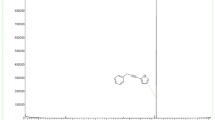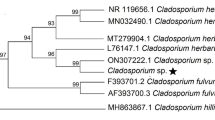Abstract
Red flour beetle Tribolium castaneum (Herbst) and rice weevil Sitophilus oryzae (L.) are considered to be the major insect pests in storage. Essential oils from aromatic plants are recognized as proper alternatives to fumigants. Thymus persicus (Ronniger ex Rech. f.) is one of these plants that have medicinal properties and is indigenous to Iran. The essential oil was obtained from aerial parts of the plant and analyzed by GC and GC–MS. Carvacrol (44.69%) and thymol (11.05%) were the major constituents of the oil extracted. In this experiment, fumigant toxicity of the essential oil was studied against T. castaneum, S. oryzae at 27 ± 1°C and 60 ± 5% RH in dark condition. The adult insects were exposed to the concentrations of 51.9, 111.1, 207.4 and 370.4 μl/l air to estimate median lethal time (LT50) values. The fumigant toxicity was increased in response to increased essential oil concentrations. The LT50 values at the lowest and the highest concentrations tested were ranged from 28.09 to 13.47 h for T. castaneum, and 3.86 to 2.30 h for S. oryzae. It was found that S. oryzae adults were much more susceptible to the oil than T. castaneum. After 24 h of exposure, the LC50 values (95% fiducial limit) for T. castaneum and S. oryzae were estimated to be 236.9 (186.27–292.81) and 3.34 (2.62–4.28) μl/l air, respectively. These results suggest that T. persicus essential oil merits further study as potential fumigant for the management of these stored-product insects.

Similar content being viewed by others
References
Adams RP (1995) Identification of essential oil components by gas chromatography/mass spectroscopy. Allured Publishing Corporation, Carol Stream
Agarwal RK, Singh KN, Sirvastava PK, Varma BK (1979) Assessment of storage losses in wheat and different refractions in periodic arrivals in mandis of Haryana. Bull Grain Technol 17:202–204
Ahn YJ, Lee SB, Lee HS, Kim GH (1998) Insecticidal and acaricidal activity of carvacrol and β-thujaplicine derived from Thujopsis dolabrata var. Hondai sawdust. J Chem Ecol 24:81–90
Amin G (1991) Popular medicinal plants of Iran, vol 1. Research Deputy of Health Ministry, Tehran
Arnason JT, Philogene BJR, Morand P, Imrie K, Iyengar S, Duval F, Soucy-Breau C, Scaiano JC, Werstiuk NH, Hasspieler B, Downe AER (1989) Naturally occurring and synthetic thiophenes asphotoactivated insecticides. In: Arnason JT, Philogene BJR, Morand P (eds) Insecticides of plant origin. ACS Symp series no 387. American Chemical Society, Washington DC, pp 164–172
Barnard D (1999) Repellency of essential oils to mosquitoes (Diptera: Culicidae). J Med Entomol 36:625–629
Campbell JF, Runnion C (2003) Patch exploitation by female red flour beetles, Tribolium castaneum. J Insect Sci 3(20) 8 pp. Available at http://www.insectscience.org/3.20
Choi W-S, Park B-S, Lee Y-H, Jang DY, Yoon HY, Lee S-E (2006) Fumigant toxicities of essential oils and monoterpenes against Lycoriella mali adults. Crop Prot 25:398–401
Chokechaijaroenporn O, Bunyapraphatasara N, Kongschensis S (1994) Mosquito repellent activities of Ocimum volatie oils. Phytomedicine 1:135–139
Clemente S, Mareggiani G, Broussalis A, Martino V, Ferraro G (2003) Insecticidal effects of Lamiaceae species against stored products insects. Bol San Veg Plagas 29:1–8
Daglish GJ, Eelkema M, Harrison LM (1996) Contorol of Sitophilus oryzae (L.) (Coleoptera: Curculionidae) in paddy rice using chloropyrifos-methyl or fenintrothion in combination with several other protectants. J Stored Prod Res 32:247–253
Evans DE (1987) Stored products. In: Burrn Aj, Coaker TH, Jepson PC (eds) Integrated pest management. Academic Press, London, pp 425–461
Finney DJ (1971) Probit analysis, 3rd edn. Cambridge University Press, London
Hedin PA, Hollingsworth RM, Masler EP, Miyamoto J, Thompson DG (1997) Phytochemicals for pest control, ACS Symp series no. 658. American Chemical Society, Washington DC
Hori M (2003) Repellency of essential oils against the cigarette beetle, Lasioderma serricorne (Fabricius) (Coleoptera: Anobiidae). Appl Entomol Zool 38:467–473
Howe RW (1965) Losses caused by insects and mites in stored foods and food stuffs. Nutr Abs Rev 35:285–302
Hummelbrunner LA, Isman MB (2001) Acute, sublethal, antifeedant and synergistic effects of monoterpenoid essential oil compounds on the tobacco cutworm, Spodoptera litura (Lep., Noctuidae). J Agric Food Chem 49:715–720
Isman MB (2000) Plant essential oils for pest and disease management. Crop Prot 19:603–608
Isman MB (2006) Botanical insecticides, deterrents, and repellents in modern agriculture and an increasingly regulated world. Annu Rev Entomol 51:45–66
Isman MB, Machial CM, Miresmailli S, Bainard LD (2007) Essential oil-based pesticides: new insights from old chemistry. In: Ohkawa H, Miyagawa H, Lee P (eds) Pesticide chemistry. Wiley, Weinheim, pp 201–209
Jilani G, Saxena RC, Rueda BP (1998) Repellent and growth-inhibiting effects of turmic oil, sweetflag oil, neem oil, and Margosan-O on red flour beetle (Coleoptera: Tenebrionidae). J Econ Entomol 81:1226–1230
Kalemba D, Kurowska A, Gora J, Lis A (1991) Analysis of essential oils. infeluence of insects. Part V essential oils of berries of Juniper (Juniperus communis L.). Pstycydy 2:31–34
Kim SI, Roh JY, Kim DH, Lee HS, Ahn YJ (2003) Insecticidal activities of aromatic plant extracts and essential oils against Sitophilus oryzae and Callosobrochus chinensis. J Stored Prod Res 39:293–303
Lee BH, Choi WS, Lee SE, Park BS (2001) Fumigant toxicity of essential oils and their constituent compounds towards the rice weevil, Sitophilus oryzae (L.). Crop Prot 20:317–320
Naghibi F, Mosaddegh M, Mohammadi Motamed S, Ghorbani A (2005) Labiatae family in folk medicine in Iran: from ethnobotany to pharmacology. Iranian J Pharmaceut Res 2:63–79
Negahban M, Moharramipoure S, Sefidkon F (2007) Fumigant toxicity of essential oil from Artemisia sieberi Besser against three stored-product insects. J Stored Prod Res 43:123–128
Nickavar B, Mojab F, Dolat-Abadi R (2005) Analysis of the essential oils of two Thymus species from Iran. Food Chem 90:609–611
Pascual-Villalobos MJ, Robledo A (1998) Screening for anti-insect activity in Mediterranean plants. Indust Crop Prod 8:183–194
Passino GS, Bazzoni E, Moretti MDL (2004) Microencapsulated essential oils active against indianmeal moth. Bol San Veg Plagas 30:125–132
Rasooli I, Rezaei MB, Allameh A (2006) Growth inhibition and morphological altrrations of Aspergillus niger by essential oils from Thymus eriocalyx and Thymus x-prolock. Food Contr 17:359–364
Rechinger KH (1982) Flora iranica. vol 152, Akademische Druck-und Verlagsanstalt, Graz
Regnault-Roger C, Hamraoui A (1995) Fumigant toxic activity and reproductive inhibition induced by monoterpenes on Acanthosceides obtectus (Say) (Coleoptera),a bruchid of kidney bean (phaseolus vulgaris L.). J Stored Prod Res 31:291–299
Regnault-Roger C, Hamraoui A, Holeman M, Theron E, Pinel R (1993) Insecticidal effect of essential oils from mediterranean plants upon Acanthoscelides obtecus Say (Coleoptera: Bruchidae), a pest of kidney bean (Phaseolus vulgaris L.). J Chem Ecol 19:1233–1244
SAS Institute (1996) SAS/STAT users guide, release 6.12. SAS Institute Inc, Cary
Schmutterer H (1992) Control of diamondback moth by application of neem extracts. In: Talekar NS (ed) Diamondback moth and other crucifer pests. Proceedings of Second International Workshop Asian Vegetable Research and Development Center, Taipei, Taiwan, pp 325–332
Shaaya E, Ravid U, Paster N, Juven B, Zisman U, Pissarev V (1990) Fumigant toxicity of essential oils against four major stored-product insects. J Chem Ecol 17:499–504
Shaaya E, Kostjukovski M, Eilberg J, Sukprakarn C (1997) Plant oils as fumigants and contact insecticides for the control of stored-product insects. J Stored Prod Res 33:7–15
Stahl-Biskup E, Saez F (2002) Thyme: The genus Thymus. Taylor and Francis, London
Waliwitiya R, Isman M, Vernon B, Riseman A (2000) Insecticidal activity of thymol, citronellal, eugenol and rosemary oil to Agriotes obscurus (Coleoptera: Elateridae) in laboratory and greenhouse bioassays. Faculty of Agricultural Sciences, University of British Columbia, Canada
Xie YS, Fields PG, Isman MB, Chen WK, Zhang X (1995) Insecticidal activity of Melia toosendan extracts and toosendanin against three stored-product insects. J Stored Prod Res 31:259–265
Zhang Z, van Epenhuijsen CW (2004) Improved Envirosol fumigation methods for disinfesting export cut flowers and foliage crops. New Zealand Institute for Crop and Food Research Limited, Palmerston North
Author information
Authors and Affiliations
Corresponding author
Additional information
Communicated by J. Riudavets.
Rights and permissions
About this article
Cite this article
Saroukolai, A.T., Moharramipour, S. & Meshkatalsadat, M.H. Insecticidal properties of Thymus persicus essential oil against Tribolium castaneum and Sitophilus oryzae . J Pest Sci 83, 3–8 (2010). https://doi.org/10.1007/s10340-009-0261-1
Received:
Revised:
Accepted:
Published:
Issue Date:
DOI: https://doi.org/10.1007/s10340-009-0261-1




